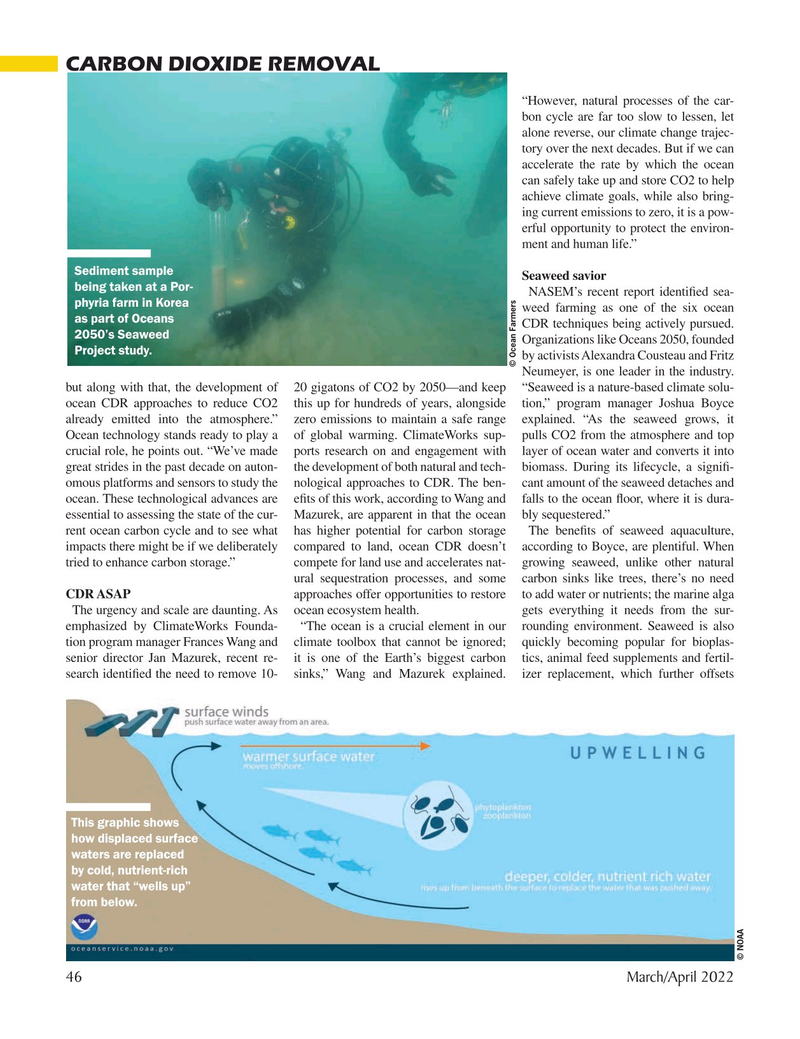
Page 46: of Marine Technology Magazine (March 2022)
Read this page in Pdf, Flash or Html5 edition of March 2022 Marine Technology Magazine
CARBON DIOXIDE REMOVAL “However, natural processes of the car- bon cycle are far too slow to lessen, let alone reverse, our climate change trajec- tory over the next decades. But if we can accelerate the rate by which the ocean can safely take up and store CO2 to help achieve climate goals, while also bring- ing current emissions to zero, it is a pow- erful opportunity to protect the environ- ment and human life.”
Sediment sample
Seaweed savior being taken at a Por-
NASEM’s recent report identi? ed sea- phyria farm in Korea weed farming as one of the six ocean as part of Oceans
CDR techniques being actively pursued. 2050’s Seaweed
Organizations like Oceans 2050, founded
Project study. by activists Alexandra Cousteau and Fritz © Ocean Farmers
Neumeyer, is one leader in the industry. but along with that, the development of 20 gigatons of CO2 by 2050—and keep “Seaweed is a nature-based climate solu- ocean CDR approaches to reduce CO2 this up for hundreds of years, alongside tion,” program manager Joshua Boyce already emitted into the atmosphere.” zero emissions to maintain a safe range explained. “As the seaweed grows, it
Ocean technology stands ready to play a of global warming. ClimateWorks sup- pulls CO2 from the atmosphere and top crucial role, he points out. “We’ve made ports research on and engagement with layer of ocean water and converts it into great strides in the past decade on auton- the development of both natural and tech- biomass. During its lifecycle, a signi? - omous platforms and sensors to study the nological approaches to CDR. The ben- cant amount of the seaweed detaches and ocean. These technological advances are e? ts of this work, according to Wang and falls to the ocean ? oor, where it is dura- essential to assessing the state of the cur- Mazurek, are apparent in that the ocean bly sequestered.” rent ocean carbon cycle and to see what has higher potential for carbon storage The bene? ts of seaweed aquaculture, impacts there might be if we deliberately compared to land, ocean CDR doesn’t according to Boyce, are plentiful. When tried to enhance carbon storage.” compete for land use and accelerates nat- growing seaweed, unlike other natural ural sequestration processes, and some carbon sinks like trees, there’s no need
CDR ASAP approaches offer opportunities to restore to add water or nutrients; the marine alga
The urgency and scale are daunting. As ocean ecosystem health. gets everything it needs from the sur- emphasized by ClimateWorks Founda- “The ocean is a crucial element in our rounding environment. Seaweed is also tion program manager Frances Wang and climate toolbox that cannot be ignored; quickly becoming popular for bioplas- senior director Jan Mazurek, recent re- it is one of the Earth’s biggest carbon tics, animal feed supplements and fertil- search identi? ed the need to remove 10- sinks,” Wang and Mazurek explained. izer replacement, which further offsets
This graphic shows how displaced surface waters are replaced by cold, nutrient-rich water that “wells up” from below. © NOAA 46 March/April 2022
MTR #3 (34-49).indd 46 2/25/2022 10:15:46 AM

 45
45

 47
47
